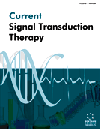- Home
- A-Z Publications
- Current Signal Transduction Therapy
- Previous Issues
- Volume 9, Issue 2, 2014
Current Signal Transduction Therapy - Volume 9, Issue 2, 2014
Volume 9, Issue 2, 2014
-
-
Hydrogen Sulfide Regulates Vascular Inflammation and its Related Signaling Pathways
More LessAuthors: Shasha Feng, Junbao Du, Selena Y. Chen, Wen Yu, Chaoshu Tang and Hongfang JinHydrogen sulfide (H2S) is regarded as one of the air pollutants with a rotten egg smell. However, it is recently discovered that endogenous H2S has important physiological and pathological functions. Cystathionine- β synthase (CBS) and cystathionine- γ lyase (CSE) play key roles in the synthesis of H2S, and CSE is also a major H2S-formation enzyme in the cardiovascular system. Vascular inflammation is one of the most importan Read More
-
-
-
MicroRNAs in Diabetic β Cell Dysfunction and their Role as Biomarkers
More LessAuthors: Yaxi Chen, Haoming Tian and Xijie YuThe maintenance of pancreatic β-cells normal functioning is crucial for insulin production and glucose homeostasis. Inadequate insulin secretion due to β-cell dysfunction can lead to different types of diabetes mellitus. Though it is widely recognized that both environmental and genetic factors play important roles, the exact molecular mechanism that leads to β -cell failure is still unclear. MicroRNAs (miRNAs) regulate numerous Read More
-
-
-
The Heterogeneity of Glioma Stem Cells
More LessAuthors: Suojun Zhang, Feng Wan, Lin Han, Fei Ye, Dongsheng Guo and Ting LeiGlioblastoma, a highly lethal brain tumor, features extensive heterogeneity at the cellular and molecular levels. The discovery of glioma stem cells (GSCs) supports a new paradigm in tumor biology and therapeutic targeting. GSCs contribute to the cellular origin of primary gliomas and the recurrence of malignant gliomas after traditional treatments. A growing body of evidence suggests that GSCs, just as the bulk tumor cell Read More
-
-
-
Signal Transduction Therapy in Pancreatic Cancer
More LessAuthors: Xiaotian Sun, Zhaoshen Li and Min LiSignal transduction has been acknowledged to be involved in various cell biological processes. And it is proved that multiple signaling pathways have been associated with the development and progression of pancreatic cancer, which remains one of the most devastating human diseases. Newly developed drugs targeting these aberrant signaling pathways show bright prospect in improving the therapeutic efficacy and outc Read More
-
-
-
Molecular Prevalence and Risk Factors of Gastroesophageal Reflux Disease in Hemodialysis Patients
More LessAuthors: Jun-Feng Hao, Xiao-Tian Sun, Jiu-Xu Bai, Xiao-Ling Zhang, Shou-Nan Wang, Bing Shao, Zhao-Shen Li and Ning CaoBackground: The association between gastroesophageal reflux disease (GERD) and hemodialysis (HD) is unclear. We aimed to determine the prevalence of GERD in HD patients and to identify the risk factors and effects of GERD in this patient population. Methods: This retrospective study involved 432 HD patients who completed a questionnaire including a GERD symptom assessment scale (QUEST). Clinical data were obtai Read More
-
-
-
Matrix Metalloproteinase Inhibitor MMI-166 Suppresses the Growth of SW1990 Human Pancreatic Cancer Cells
More LessAuthors: Junben Wu, Muhammad Shahbaz, Shujing Wang, Bengang Gong, Benjia Liang, Ruliang Fang, Bo Qiu, Min Jiang, Yang Li and Jun NiuObjectives: As a selective matrix metalloproteinase inhibitor, MMI-166 specifically inhibits MMP-2 and MMP-9 activity and represses tumor invasion and metastasis. Previous studies show that MMI-166 has an anti-metastatic role in a variety of tumors. However, it still remains unclear about the exact effect of MMI-166 on human pancreatic cancer. Methods: In this study, we showed firstly MMI-166 induced proliferation inhibition Read More
-
-
-
miR-202 Mediates Metabolic Shift in Lung Cancer Cells via Targeting HK2
More LessAuthors: Jin Li, Baohua Zhang, Qihuang Chen and Qiang LiCancer cell metabolism plays an important role in the progression of lung cancer. It is characterized through a shift from an oxidative to a glycolytic bioenergetics pathway, a phenomenon referred to as the warburg effect. However, the deregulation of miRNAs contributing to the warburg effect and to cancer cell metabolism is still unknown. In the present study, the results demonstrate that the expression of miR-202 is significant Read More
-
-
-
Nephro-Protective Effect of Cortex Lycii Radicis Extracts in Streptozotocin- Induced Diabetic Rats
More LessBackground: To evaluate the effects of aqueous Cortex Lycii Radicis (CLR) extracts on diabetic nephrology in a streptozotocin-induced diabetic nephropathy rat model, and to explore the underlying mechanisms of CLR action. Methods: We induced diabetes mellitus via a single intravenous streptozotocin injection (30 mg/kg) and subsequent high-fat diet for 3 weeks in male Sprague Dawley rats. Rats that developed diabetes Read More
-
Volumes & issues
-
Volume 20 (2025)
-
Volume 19 (2024)
-
Volume 18 (2023)
-
Volume 17 (2022)
-
Volume 16 (2021)
-
Volume 15 (2020)
-
Volume 14 (2019)
-
Volume 13 (2018)
-
Volume 12 (2017)
-
Volume 11 (2016)
-
Volume 10 (2015)
-
Volume 9 (2014)
-
Volume 8 (2013)
-
Volume 7 (2012)
-
Volume 6 (2011)
-
Volume 5 (2010)
-
Volume 4 (2009)
-
Volume 3 (2008)
-
Volume 2 (2007)
-
Volume 1 (2006)
Most Read This Month
Article
content/journals/cst
Journal
10
5
false
en


